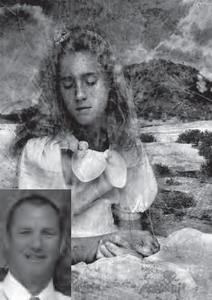

Portrait of Scout in an African Landscape by Douglas A. Douglas (artist shown inset left).
*** Reprinted by permission from the Virginia Intermont College alumni magazine, Winter 2010. ***
BRISTOL, VA -- A lust-for-more painter who lives in the studio is a fitting description of David A. Douglas -- now and also back in college. At Virginia Intermont College in the late '70s, he thrived like a hermit in the former basement art studio in Smith-Canter gym.
Today, although he has been painting more than 25 years and exhibits extensively, a learning studio remains his favorite place. No wonder. It is one of the earliest memories of his life and best of VI.
"I knew when I was five-years-old I wanted to be an artist," says Douglas who grew up in Alexandria, Va., surrounded by a family of artists and art professionals. A great uncle was an excellent painter, and Douglas says he spent so much time in his studio, you could say he grew up there, totally fascinated by the process of his uncle's work and how art was part of the process of his life.
"I remember first walking in and being blown away, deciding right then that's what I wanted to do."
It is not unlike how Douglas found Virginia Intermont. After high school, he entered Virginia Commonwealth University, top-rated for the arts. But he felt unsupported and uninspired. He left after a year, stayed out of college and worked. One day, his father encouraged him to check back for advice from a high school administrator. It turned out he was a relative of VI's admissions director at the time and recommended VI's outstanding visual arts program.
As soon as Douglas visited Bristol and met with professors, including Marvin Tadlock, Jay Phyfer and the late Tedd Blevins, he was impressed. "It was so much more personalized. As a young artist, I was interested in finding a place where it would be easy to develop relationships, be mentored and work side-by-side with professors."
In just a day of visiting, he felt like he had made friends. "People were warm and inviting and interested in me," he says.
His experience as a student over the next several years proved even better than expected. "We had this great group of artists, students and professors, who were very individual thinkers, liberal-minded and determined to shout out what we wanted to," in terms of art, he says. "We pushed the boundaries. We questioned things. It was very exciting and refreshing. We all learned, even the people who weren't in our department got something out of it."
Uniquely VI, Douglas says, was the support of people who were willing to help him achieve his goals. "The closeness is like a family who cares about you."
He says Dr. Tadlock treated him more like a colleague than a student. "He and Tedd [Blevins] both wanted me to learn but didn't impose their will. They were working artists, and I learned working alongside them."
Douglas brought talent, confidence and discipline to the studio, and an appreciation that making art is a way of approaching not only a project, but also each day and, in essence, life.
"I lived in the studio at VI and loved it," he says. "I loved being like those guys. I wanted to out-work them. I was driven. I remember first seeing Marvin throw clay on a pottery wheel and thinking, "damn, I want to do that.' And I wanted mine to be the tallest and the best. And I wanted to spend the most time in the studio working on it."
"We were really going for it," he says, and the emphasis was to not be complacent, but rather responsible for individual creativity and the use of it. "It was an awesome, incredible environment."
After earning a Bachelor of Arts in painting in 1981, Douglas pursued a master's from James Madison University and became a serious painter who also teaches. Returning to his native Alexandria, with family ties going back three generations, he thrives on inspiration from his family, including his wife Ann (also a teacher), a daughter and son, and an adopted son from Zimbabwe.
He has exhibited in major galleries in Washington and across the south, receiving favorable reviews, and has work in collections at the Chrysler Museum in Norfolk, Va., and the Virginia Museum in Richmond, among others. He has traveled for international exhibition in Spain, and four years ago, began showing pieces from a unique series, "The African Works," large-scale paintings that tell the story of Douglas's relationship with Gift, his adopted teenage son.
Each piece from "African Works," he says, represents a connection (or composite of connections) to life in Bulawayo, Zimbabwe and in Alexandria. An accurate expression of this is a portrait of his daughter Scout in an African landscape, although she didn't make the trip. Douglas paints her in a pretty white dress "yet set slightly aloft in a vast raw space ... jarring the senses as you ponder themes of innocence, danger and loss. You have to reconcile your notion of parenthood, how you hang as tightly as you possibly can and then how you reluctantly (and slowly) have to let go."
The painting debuted at the Angie Newman Johnson Gallery at the Episcopal High School where Douglas teaches. Curator Frank Phillips wrote that the first thing you notice is that the work "radiates..." Mounted directly to the wall in a frame, "these images feel like the walls were cut open in perfect rectangles, revealing a different universe. The works tempt the viewers' idea of reality. You literally want to touch the pieces to make sure it's only a picture. And at times, you teeter between passive viewing and actively entering the massive landscapes."
Douglas's strength and willingness, vitally explored at VI, to "push the boundaries" demonstrates that his lust-for-more in the studio is truly inspiring for him and for the students he encourages to do the same.